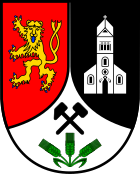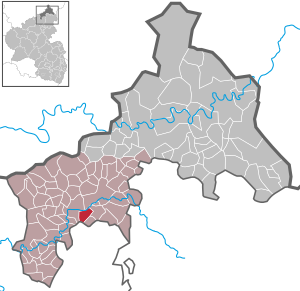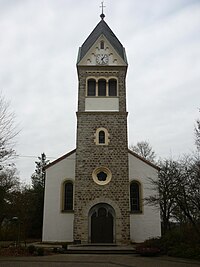Schöneberg (Westerwald)
| coat of arms | Germany map | |
|---|---|---|

|
Coordinates: 50 ° 40 ′ N , 7 ° 36 ′ E |
|
| Basic data | ||
| State : | Rhineland-Palatinate | |
| County : | Altenkirchen (Westerwald) | |
| Association municipality : | Altenkirchen-Flammersfeld | |
| Height : | 220 m above sea level NHN | |
| Area : | 3.2 km 2 | |
| Residents: | 416 (Dec. 31, 2019) | |
| Population density : | 130 inhabitants per km 2 | |
| Postal code : | 57638 | |
| Area code : | 02681 | |
| License plate : | AK | |
| Community key : | 07 1 32 099 | |
| Association administration address: | Rathausstrasse 13 57610 Altenkirchen |
|
| Website : | ||
| Local Mayor : | Frank Iwanowski | |
| Location of the local community Schöneberg in the district of Altenkirchen (Westerwald) | ||
Schöneberg is a municipality in the Altenkirchen (Westerwald) district in Rhineland-Palatinate . It belongs to the community of Altenkirchen-Flammersfeld .
Geographical location
Schöneberg is located about four kilometers southwest of the city of Altenkirchen near the federal highway 256 and one kilometer east of Neitersen . Other neighboring communities are Almersbach and Fluterschen in the west and Stürzelbach in the south.
history
The oldest document about the place Schöneberg is from the year 1240, in which the parish of Schöneberg (" ecclesiam de Shoninberch ") is mentioned. It belonged to the St. Florin Abbey in Koblenz. Based on older documents pertaining to places in the parish, it can be assumed that Schöneberg is significantly older.
In recent history, Schöneberg made a name for itself as a community that supported National Socialism at an early stage. Even before the seizure of power in 1933, Schöneberg was the second place in the German Reich to declare Adolf Hitler an honorary citizen.
County Sayn
Count Heinrich III. von Sayn died childless in 1246. His widow, Mechthild von Sayn , gave the Cistercian monastery she founded in Herchen the large and small tithe of Schöneberg in 1249, and Mechthild handed over the manorial rights to Archbishop Konrad of Cologne in 1250 . Siegfried , a successor to Konrad, gave the manor to Count von Berg as a fief . In the late Middle Ages, the Counts of Wied were sovereigns. In 1489 Schöneberg finally came under the rule of the Counts of Sayn . From 1671 to 1799 Schöneberg belonged to the County of Sayn-Hachenburg .
Parish court
Schöneberg belonged to the Saynischen Amt Altenkirchen, which is mentioned for the first time in 1490. In 1507 a parish court was set up in Schöneberg , which may already have been set up by the Counts of Wied. A mayor was appointed as court clerk . The judicial district included the places Berzhausen , Bettgenhausen, Hoppach, Kahlhardt, Kindessem, Luyzenhausen, Mangeroth, Neiterschen, Niederorien, Obernau , Seifen and Seltzenthal. The court existed until around 1618.
Schöneberg Office
Until the division of the county into Sayn-Altenkirchen and Sayn-Hachenburg , Schöneberg was administered by the Saynischen Amt Altenkirchen. From 1691 at the latest, the parish belonged to the Hachenburg office in the county of Sayn-Hachenburg. In 1723 the office of Schöneberg was established and also became the first instance for the parishes of Hamm , Höchstenbach and Altstadt . Even after the county of Sayn-Hachenburg fell to the Counts of Nassau-Weilburg in 1799 and belonged to the Duchy of Nassau in 1806 , Schöneberg remained the official seat and belonged to the Nassau administrative district of Ehrenbreitstein . In 1815 various areas of Nassau were ceded to Prussia . The Schöneberg office was merged with the Altenkirchen office. After the establishment of the Prussian mayor's offices and districts, Schöneberg belonged to the Flammersfeld mayor's office in the Altenkirchen district and from 1822 to the Rhine Province . Since the administrative reform in 1970, Schöneberg has been part of the Altenkirchen Association , which later became the Altenkirchen-Flammersfeld Association .
Religious affiliation
Schöneberg belonged to the Archdiocese of Trier and belonged to the county of Sayn . As a result of the Saynic Reformation, the inhabitants of the parish became a Lutheran community in 1561 , and the Reformed Confession was introduced in 1605 . In 1665, under Countess Louise Juliane, a Lutheran congregation was established alongside the Reformed church. The two parishes of Schöneberg joined the uniate church of the Rhineland in 1817 . In 1893 the catchment area of the parish was expanded. Niederölfen, Fladersbach, Neitersen and Obernau (on the right of the Wied ) were added to the old parish towns . Today the parish of Schöneberg belongs to the Altenkirchen parish of the Evangelical Church in the Rhineland .
Schöneberg Castle
From around 1500 there was a small castle in Schöneberg, which in the few available sources was also called "Haus Schöneberg". It is very likely that the castle stood on the plateau on which the church now stands. The Schönberg house was first mentioned in 1507 and served Countess Johanetta († 1529), the wife of Gerhard III. von Sayn († 1493), as a widow's residence. In 1685 the castle is described as having "two large rooms and 14 smaller chambers, an upper floor and a cellar". The castle was converted into a hunting lodge through renovations at the beginning / middle of the 18th century and is last mentioned in 1794. It was probably destroyed in the armed conflict in the years after 1794. The street name Schloßweg is reminiscent of the building.
church
On May 23, 1854 a fire broke out in the village, over half of the village burned down, the old Romanesque church, the rectory and 18 houses. After the construction of a new rectory was completed in 1858, the foundation stone was laid in 1864 for a new, considerably larger neo-Gothic church. The erection of a tower caused problems at the time, as one probably came across remains of the former castle underground. In 1874 it had to be demolished until the new tower, visible from afar, was completed in 1908. The church is called "Church of the Resurrection".
school
The first school in Schöneberg was established before 1618, and in 1644 the first schoolmaster is mentioned by name. At times there were two schools, one Reformed and one Lutheran. A winter school was set up in the 18th century. In the 19th century the school was located in the sexton building, the children from Schöneberg and Neiterschen were taught. In 1873 a school hall was added. The school was closed in 1973 and now serves as a village community center. The children have been attending schools in Altenkirchen since then.
Mining
Mining in Schöneberg has been documented since 1847. In the documents of the Bergamt Koblenz there is a reference to an already existing mining of iron stone. Finds of cinder residues in the hallway "Auf dem Hähnen" show that iron smelting also took place here. In addition to iron, the permit issued in 1847 for the "Gute Aussicht" and "Emma" pits also granted mining rights for lead and copper. In the following years, mining rights were granted for four more pits. In 1906 5,446 tons of iron ore were mined and 86 workers were employed. The mining operations ceased in 1909. Schöneberg belonged to the Hamm (Sieg) mountain area.
Population development
The development of the population of Schöneberg, the values from 1871 to 1987 are based on censuses:
|
|
politics
Municipal council
The council in Schöneberg consists of eight council members, who in the local elections on May 26, 2019 in a majority vote were elected, and the honorary mayor as chairman.
mayor
Frank Iwanowski became mayor of Schöneberg on July 18, 2019. In the direct election on May 26, 2019, he was elected for five years with 92.90% of the vote. Frank Iwanowski's predecessor was Jürgen Schneider, who held the office for 20 years.
economy
There are no longer any farms in Schöneberg. Several craft and trading companies as well as a conference center will maintain some jobs on site, while the majority of those in employment will a. commutes to nearby Altenkirchen.
Cultural monuments
literature
- Daniel Schneider: The development of denominations in the county of Sayn in the plan. In: Heimat-Jahrbuch des Kreis Altenkirchen 58. 2015, pp. 74–80.
- Lutz Sartor: 1240–1990. On the history of Schöneberg. On the occasion of the 750th anniversary published by the Schöneberg community, Schöneberg 1990.
Web links
- Local community Schöneberg on the website of the community community Altenkirchen
- The Schöneberg community presents itself on its own side
Individual evidence
- ↑ a b State Statistical Office of Rhineland-Palatinate - population status 2019, districts, municipalities, association communities ( help on this ).
- ↑ Lutz Sartor: 1240–1990. On the history of Schöneberg. On the occasion of the 750th anniversary published by the Schöneberg community, Schöneberg 1990.
- ↑ a b c d e Lutz Sartor: The history of my home community Schöneberg near Altenkirchen-Westerwald. Retrieved on November 7, 2017 ( Taken from the 1980 and 1981 yearbooks of the Altenkirchen / Westerwald district home association.).
- ↑ The brave Schöneberg. The Führer was an honorary citizen for ten years. In: Völkischer Beobachter from August 14, 1942
- ↑ a b Hellmuth Gensicke : Landesgeschichte des Westerwaldes . Ed .: Historical Commission for Nassau. 3. Edition. Wiesbaden 1999, ISBN 3-922244-80-7 , pp. 391, 476 .
- ^ Yearbook of the Association for Nassau antiquity and historical research (= Nassau Annals . Volumes 9-10). 1868, p. 270, 315 ( limited preview in Google Book Search [accessed November 7, 2017]).
- ↑ On denominational development cf. Daniel Schneider: The development of denominations in the county of Sayn in the plan, pp. 74-80.
- ↑ State Statistical Office Rhineland-Palatinate - regional data
- ^ The Regional Returning Officer Rhineland-Palatinate: City Council Election 2019 Schöneberg. Retrieved December 28, 2019 .
- ^ Local community Schöneberg: Constituent meeting of the local community council. July 15, 2019, accessed December 28, 2019 .
- ^ The Regional Returning Officer Rhineland-Palatinate: direct elections 2019. see Altenkirchen-Flammersfeld, Verbandsgemeinde, 55th line of results. Retrieved December 28, 2019 .






